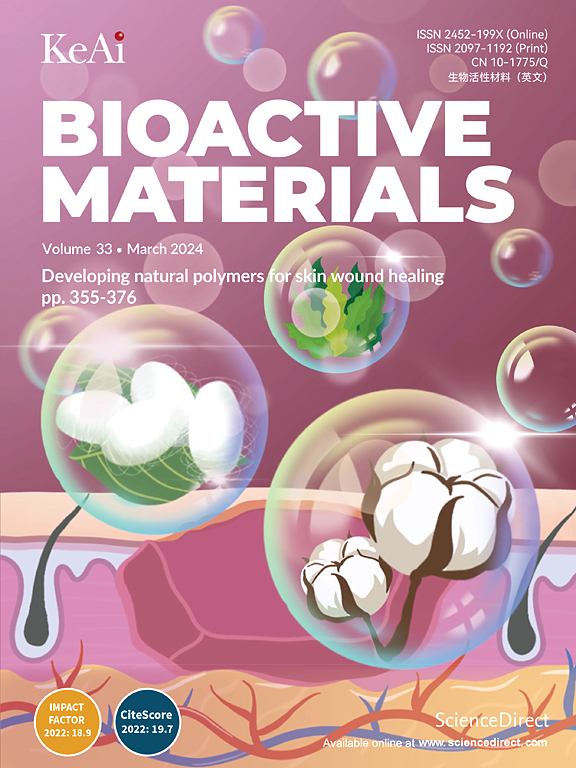Bioprinting of Alginate-Norbornene bioinks to create a versatile platform for kidney in vitro modeling
IF 18
1区 医学
Q1 ENGINEERING, BIOMEDICAL
引用次数: 0
Abstract
Chronic kidney diseases affect a significant portion of the global population and their prevalence is expected to increase in the coming years. Advanced in vitro models are crucial for understanding disease onset and for improving drug testing. Emerging strategies have enhanced the accuracy of these models by incorporating 3D culture and perfusion systems. Notably, efforts have focused on modeling the nephron, particularly endothelialized and epithelialized tubular structures, with perfusion to simulate toxin exchange for nephrotoxicity testing. New approaches combining biomaterials with patient-derived kidney epithelial cells show promise for high-throughput personalized drug screening. However, these methods often rely on decellularized extracellular matrix materials, such as Matrigel® and collagen, which suffer from batch-to-batch variability. To address reproducibility issues, we used norbornene-functionalized alginate to produce peptide-functionalized thiol-ene crosslinked hydrogels. By varying the composition of crosslinkers and peptide functionalization, we tuned the cell interaction with the hydrogels. The rapid reaction kinetics enabled the bioprinting of cell-laden tubular structures using microfluidic bioprinting, without the need for ionic crosslinking, by adapting the printer with UV irradiation at the nozzle. The bioprinted fibers successfully formed monolayers, indicating their potential for creating advanced kidney in vitro models. Thiol-ene crosslinked hydrogels proved to be highly tunable and adaptable to microfluidic bioprinting, demonstrating significant promise for further application to create kidney in vitro models.

海藻酸盐-降冰片烯生物链接的生物打印为肾脏体外建模创造了一个多功能平台
慢性肾脏疾病影响了全球人口的很大一部分,预计其患病率将在未来几年增加。先进的体外模型对于了解疾病的发病和改进药物测试至关重要。新兴策略通过结合3D培养和灌注系统提高了这些模型的准确性。值得注意的是,努力集中在模拟肾单位,特别是内皮化和上皮化的管状结构,灌注模拟肾毒性测试的毒素交换。将生物材料与患者源性肾上皮细胞相结合的新方法有望实现高通量个性化药物筛选。然而,这些方法通常依赖于脱细胞的细胞外基质材料,如Matrigel®和胶原蛋白,这些材料存在批次间的可变性。为了解决可重复性问题,我们使用降冰片烯功能化海藻酸盐来生产肽功能化巯基交联水凝胶。通过改变交联剂和肽功能化的组成,我们调整了细胞与水凝胶的相互作用。快速反应动力学使得使用微流控生物打印技术进行细胞负载管状结构的生物打印成为可能,而不需要离子交联,只需在喷嘴处使用紫外线照射打印机即可。生物打印纤维成功地形成了单层,这表明它们有可能在体外制造先进的肾脏模型。巯基交联水凝胶被证明是高度可调的,适合微流体生物打印,显示出进一步应用于创建体外肾脏模型的重大前景。
本文章由计算机程序翻译,如有差异,请以英文原文为准。
求助全文
约1分钟内获得全文
求助全文
来源期刊

Bioactive Materials
Biochemistry, Genetics and Molecular Biology-Biotechnology
CiteScore
28.00
自引率
6.30%
发文量
436
审稿时长
20 days
期刊介绍:
Bioactive Materials is a peer-reviewed research publication that focuses on advancements in bioactive materials. The journal accepts research papers, reviews, and rapid communications in the field of next-generation biomaterials that interact with cells, tissues, and organs in various living organisms.
The primary goal of Bioactive Materials is to promote the science and engineering of biomaterials that exhibit adaptiveness to the biological environment. These materials are specifically designed to stimulate or direct appropriate cell and tissue responses or regulate interactions with microorganisms.
The journal covers a wide range of bioactive materials, including those that are engineered or designed in terms of their physical form (e.g. particulate, fiber), topology (e.g. porosity, surface roughness), or dimensions (ranging from macro to nano-scales). Contributions are sought from the following categories of bioactive materials:
Bioactive metals and alloys
Bioactive inorganics: ceramics, glasses, and carbon-based materials
Bioactive polymers and gels
Bioactive materials derived from natural sources
Bioactive composites
These materials find applications in human and veterinary medicine, such as implants, tissue engineering scaffolds, cell/drug/gene carriers, as well as imaging and sensing devices.
 求助内容:
求助内容: 应助结果提醒方式:
应助结果提醒方式:


